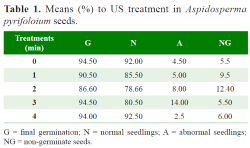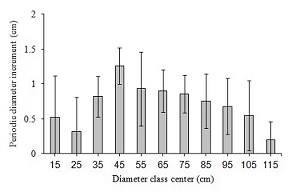Writing and formatting
Original articles
- Limited to 30 pages, numbered, including tables and figures. The text should contain the title, abstract and index terms (all three in English and Portuguese); introduction; material and methods; results; discussion; conclusions; acknowledgements and references. Subheadings should not be numbered, but rather written in italics with only the first letter capitalized.
- Title: Should be brief and informative, and not exceed 15 words in lower case. If the title contains a species name, use only the binomial nomenclature. Do not include formulas or abbreviations.
- Abstract: An abbreviated form of the manuscript; it should include the objective, simplified methodology, and main results and/or conclusions. Maximum 200 words. The abstract must be similar in Portuguese and English.
- Index terms: List three terms; words in the title will not be accepted. Do not use general terms, plurals or abbreviations. Preferably use terms from the AGROVOC Multilingual Thesaurus.
- Introduction: describe the state of the art in the topic under study, providing context for the importance of the scientific problem addressed in the manuscript. It should be objective and consistent, listing the motive for the research, with a review of the literature on the topic (as up-to-date as possible). It should conclude by expressing the main objective of the study, without methodological details.
- Material and methods: describe these objectively and in full, so the study can be reproduced. Previously published methods should be presented briefly and referenced. Describe adaptations of existing methods, when applicable.
- Results: describe findings objectively and briefly, without interpretations/comparisons. The text should not contain a description of all the content presented in the tables and figures, but instead highlight the most relevant points.
- Discussion: the results should be discussed critically and logically, and supported by the scientific literature.
- Conclusions / Final considerations: The most important aspects of the manuscript should be clearly presented. Do not repeat the findings.
- Acknowledgments and funding sources: when appropriate, list the institutions, funding agencies, and/or people who assisted in the project.
- References: must follow the specific PFB guidelines. Authors are responsible for a curacy and formatting of references to publications that were consulted and mentioned in the manuscript. All works cited in the text should be listed in the References section.
- Abbreviations and acronyms: The first mention in each section should be written out in full in lower case, followed by the respective acronym in parentheses. Afterwards, use only the acronym. The International System of Units (SI) should be adopted for units of measurement.
---------------------------------
Review articles
- Suggested length of up to 40 pages, including tables and figures. The text should include: title, abstract and indexing terms (all in Portuguese and English); introduction; main text (with sub-items, if necessary); conclusions/final considerations; acknowledgements and references.
- Follow the guidelines for each section of the article.
- The main text should present a critical review of the literature, subdivided into items if necessary.
--------------------------------
Scientific Notes
- Suggested length of up to 10 pages, including tables and figures.
- The text should contain title, abstract, index terms (all in Portuguese and English), main text (introduction, materials and methods, results and discussion) should be presented without subheadings; conclusions, acknowledgements and references.
- Follow the guidelines for each section of the article.
- Abstract: an abbreviated form of the manuscript; it should include the objective, simplified methodology, and main results and/or conclusions. Maximum 100 words. The abstract must be similar in Portuguese and English.
--------------------------------------------
Graphic elements
- PFB considers graphic elements to be tables, figures and equations.
- The location and year must be provided for results of empirical studies.
--------------------------------------------
Tables
- Tables are to be numbered sequentially with Arabic numerals and included in the body of the text, preceded by their respective itles.
- Table titles: use lower case; titles must be concise and not divided into two or more sentences.
- Source: if the data cited have been published, state the source and include it in the references.
- Notes: indicate notes with superscript symbols or Arabic numerals to the right of the word/number in the title, heading, body or column of the table. The notes should be presented continuously, separated by semicolons.
- Create tables within your word processing software; do not insert tables as figures.
- Leave external columns open (without borders).
- Headings for each column should be written in full, with only the first letter capitalized. If this is not possible, explain the abbreviations in the notes.
- Abbreviate all units of measurement according to the International System of Units (SI).
- In columns of data, the numbers should be aligned according to the unit. Standardize the decimal place for each variable.
Example:

--------------------------------------------
Figures
- Graphs, drawings, maps and photographs are all considered figures.
- Avoid using non-original figures. If they are essential to the manuscript, obtain use authorization from the copyright holder and forward this permission to the Editor; if the figure is adapted, also include authorization from the author of the original figure.
- Do not use figures generated by artificial intelligence (AI).
- Figures should be numbered sequentially with Arabic numerals and presented in the main text, followed by their respective titles and notes, when necessary.
- State authorship credits for all figures to the Editor.
- Figure titles: use lower case; titles must be concise and not divided into two or more sentences.
- Notes: should be presented continuously, separated by a semicolon.
- For final editing, send figures in separate files (.tiff, .png or .jpeg) with minimum resolution of 300 dpi.
- Do not use bold text in figures.
- Identify axes with only the first letter capitalized; indicate units in parentheses. Draw axis lines in black for better visibility.
Example:

--------------------------------------------
Equations
- Number equations sequentially with Arabic numerals within the body of the text.
- Use Equation Editor.
- Note: Identify the variables without abbreviations in lower case, sequentially and separated by a semicolon, capitalizing only the first letter in each phrase.
--------------------------------------------
Citations
- PFB does not accept direct citations, citations of citations, abstracts, personal communications, undergraduate final projects, documents in press, or any other source of unpublished data (gray literature).
- When possible, avoid self-citation.
- Citations from dissertations/theses that are more than two years old must be justified to the Editor (in the cover letter).
Standardize references according to the ABNT guidelines, with some adaptations highlighted below:
Citations in parentheses:
- One author: author’s surname capitalized and followed by a comma and the year of publication. Ex. (Himoyama, 2005).
- Two authors: authors' surnames only, capitalized and linked by &, followed by a comma and the year of publication. Ex. (Wendling & Santin, 2015).
- More than two authors: first author’s surname, capitalized and followed by et al. (in normal text, not italicized), a comma and the year of publication. Ex. (Yamashita et al., 2016).
- More than one work: they must be listed in chronological order followed by alphabetical order of the authors’ names, separated by a semicolon. Ex. (Millennium Ecosystem Assessment, 2003; Mikich et al., 2015; Mora, 2015).
In-line citations:
- Names of the authors included within the sentence: follow the previous guidelines, placing the years of publication in parentheses.
- For multiple publications by the same author(s), the years of publication should be presented in parentheses , separated by commas. Ex. Bellinger et al., (2015), McAdam (2012, 2015).
Cases involving citation formats not considered above will be decided by the Editorial Committee.
--------------------------------------------
References
- All references cited in the manuscript must be included in the reference list.
- Preferably use citations from nationally and internationally indexed journals, and at least 70% of the cited sources should have been published over the past 10 years.
PFB uses ABNT reference format, with some adaptations highlighted below:
- References should be listed in alphabetical order.
- Capitalize author surnames.
- Sources with two authors: capitalized surnames linked by &.
- Sources with more than two authors: first author’s surname, capitalized and follow ed by et al. (in regular non-italicized) font.
- Write titles of journals and general publications (thesis, books, etc.) in bold.
- Scientific names in titles should be written in italic.
--------------------------------------------
Sample references:
Original articles
Template: Author of the article. Article title: subtitle. Journal title in full (first letter capitalized), volume and/or year, issue and/or number, first and last pages of the article and year (linked by a hyphen). DOI (full URL).
Ex.: Yamashita, N. et al. Impact of leaf removal on initial survival and growth of container-grown and bare-root seedlings of Hinoki cypress (Chamaecyparis obtusa). Forest Ecology and Management, v. 370, p. 76-82, 2016. https://doi.org/10.1016/j.foreco.2016.03.054.
--------------------------------------------
Book
Template: Author of the book. Title: subtitle. Edition. Place of publication: Publisher, year of publication. Total number of pages (title of series, number in series).
Ex.: Fowler, J. et al. Practical statistics for field biology. 2nd. ed. New Jersey: John Wiley & Sons, 2009. 272 p.
--------------------------------------------
Book Chapter
Template: Author of the referenced portion. Title of the referenced portion: subtitle. In: Author of the book. Title: subtitle. Edition. Place of publication: Publisher, year of publication. Volume, tome, portion, chapter and/or first and last pages of the referenced part (Title of the series, number in the series).
Ex.: Mikich, S. B. et al. O papel do macaco-prego Sapajus nigritus na dispersão de sementes e no controle potencial de insetos-praga em cultivos agrícolas e florestais. In: Parron, L. M. et al. (ed.). Serviços ambientais em sistemas agrícolas e florestais do Bioma Mata Atlântica. Brasília, DF: Embrapa, 2015. p. 257-265.
--------------------------------------------
Full paper published in event proceedings
Template: Author of the referenced paper. Title of the paper: subtitle. In: Name of the event, number, year held. Title of publication: subtitle of publication. Place of publication: Publisher, year of publication. First and last pages of the referenced paper.
Ex.: Gomes, P. B. et al. Classificação de florestas naturais e plantadas no bioma Pampa com imagens de satélite multi-sensor e análise orientada a objeto. In: Simpósio Brasileiro de Sensoriamento Remoto, 17., 2015, João Pessoa. Anais [...]. São José dos Campos: INPE, 2015. p. 1478-1485.
--------------------------------------------
Dissertation/Thesis (Avoid)
Template: Author of the work. Title of the publication: subtitle if applicable. Year of publication. Number of pages. Type of document (academic degree), affiliation, place and date of defense (when different from the date degree was granted).
Ex.: McAdam, E. Using remote sensing and process-based growth modeling to predict forest productivity across Western Oregon. 2015. 48 f. Thesis (Master of Science) Oregon State University, Oregon.
--------------------------------------------
Legislation, Normative instructions, Regulations
Template: Jurisdiction (country, state, municipality) or entity. Title, number, date of publication. Publication data. Note.
Ex.: Council of the European Communities. Directive 2009/147/EC of the European Parliament and of the Council of 30 November 2009 on the conservation of wild birds. Official Journal of the European Union, Jan. 26, 2010. Available from: https://eur-lex.europa.eu/eli/dir/2009/147/oj. Access on: Mac. 19, 2021.
--------------------------------------------
Technical standards
Template: Standardizing agency (followed by location, if necessary). Standard number: title: subtitle. Place, year of publication. Number of pages.
Ex.: European Committee for Standardization. EN 252: field test method for determining the relative protective effectiveness of a wood preservative in ground contact. Brussels, 1989.
--------------------------------------------
Research data available in repositories
Template: Creator (author of the data). Title. Publisher: Name of the repository/database where the research data is stored. Year of publication/creation. Resource type. Identifier. Version and other information. Available at: [insert link]. Accessed on: [day month year].
Ex.: Souza, V. C. Gimnospermas. Jardim Botânico do Rio de Janeiro: Lista de Espécies da Flora do Brasil, 2015. Disponível em: http://reflora.jbrj.gov.br/jabot/floradobrasil/FB128477. Acesso em: 19 mar. 2021.
--------------------------------------------
Documents in digital media
Template: Author of the content. Title: subtitle. Available publication data: URL of the content. Accessed on: [day month year].
Ex.: Millennium Ecosystem Assessment. Ecosystems and human well-being: a framework for assessment. Washington, DC: Island Press, 2003. 245 p. Available from: http://pdf.wri.org/ ecosystems_human_wellbeing.pdf. Access on: 9 out. 2014.
--------------------------------------------
Additional Information
The journal recommends that authors record and deposit biological reference materials in registered collections that are open for public consultation, and also record and deposit DNA sequences in appropriate databases. Please state the record/identification number of these materials in the manuscript.
Research involving humans and/or animals must comply with the applicable ethical and regulatory standards in the country where the research was conducted.
PFB utilizes the International System of Units (SI). Below are some examples of how to present numerical values:
|
Instead of |
Use |
|
72 hours |
72 h |
|
5 minutes |
5 min |
|
3 seconds |
3 s |
|
10 l (liters) |
10 L |
|
20 ml |
20 mL |
|
3 metric tons |
3 t ou Mg |
|
25°C |
25 °C |
|
5 % |
5% |
|
gram per plant |
g plant-1 |
|
metric ton per hectare per year |
t ha-1 year-1 |
|
Units of Concentration (solutions) |
|
|
percent by weight by weight |
w/w |
|
percent by weight by volume |
w/v |
|
percent by volume |
v/v |
|
Parts per Million |
ppm |
|
degrees Brix |
°Brix |
Do not mention trademarks (companies, products, commercial equipment). Any exceptional cases should be justified and will be analyzed by the Editorial Committee.
Any mention of methods, brands, products, or equipment in manuscripts does not imply recommendation by the Editorial Committee.
The opinions and concepts expressed in manuscripts are the sole responsibility of their respective authors and not PFB
--------------------------------------------------------------------------------
Updated November 21th, 2024





